The Pale Blue Dot
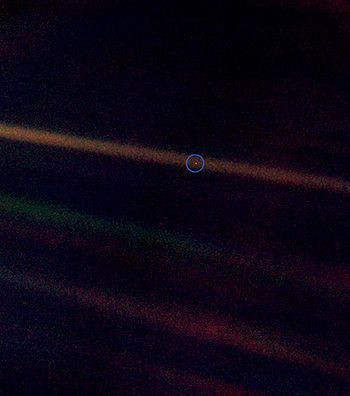
The Pale Blue Dot
The “Pale Blue Dot” is a photograph of planet Earth taken in 1990 by Voyager 1 from a record distance, showing it against the vastness of space.
By request of Carl Sagan, NASA commanded the Voyager 1 spacecraft, having completed its primary mission and now leaving the Solar System, to turn its camera around and to take a photograph of Earth across a great expanse of space. Reflecting on this picture (now considered one of the most important pictures in all of human history) Carl Sagan said:
“From this distant vantage point, the Earth might not seem of particular interest. But for us, it’s different. Consider again that dot. That’s here, that’s home, that’s us. On it everyone you love, everyone you know, everyone you ever heard of, every human being who ever was, lived out their lives. The aggregate of our joy and suffering, thousands of confident religions, ideologies, and economic doctrines, every hunter and forager, every hero and coward, every creator and destroyer of civilization, every king and peasant, every young couple in love, every mother and father, hopeful child, inventor and explorer, every teacher of morals, every corrupt politician, every “superstar,” every “supreme leader,” every saint and sinner in the history of our species lived there – on a mote of dust suspended in a sunbeam.
The Earth is a very small stage in a vast cosmic arena. Think of the rivers of blood spilled by all those generals and emperors so that, in glory and triumph, they could become the momentary masters of a fraction of a dot. Think of the endless cruelties visited by the inhabitants of one corner of this pixel on the scarcely distinguishable inhabitants of some other corner, how frequent their misunderstandings, how eager they are to kill one another, how fervent their hatreds.
Our posturings, our imagined self-importance, the delusion that we have some privileged position in the Universe, are challenged by this point of pale light. Our planet is a lonely speck in the enveloping cosmic dark. In our obscurity, in all this vastness, there is no hint that help will come from elsewhere to save us from ourselves.
The Earth is the only world known so far to harbor life. There is nowhere else, at least in the near future, to which our species could migrate. Visit, yes. Settle, not yet. Like it or not, for the moment the Earth is where we make our stand.
It has been said that astronomy is a humbling and character-building experience. There is perhaps no better demonstration of the folly of human conceits than this distant image of our tiny world. To me, it underscores our responsibility to deal more kindly with one another, and to preserve and cherish the pale blue dot, the only home we’ve ever known.”
More Posts from Sergioballester-blog and Others









The Planets (BBC) - Jupiter and Io

NASA’s Perseverance takes first photo.
Solar System 10 Things: Looking Back at Pluto
In July 2015, we saw Pluto up close for the first time and—after three years of intense study—the surprises keep coming. “It’s clear,” says Jeffery Moore, New Horizons’ geology team lead, “Pluto is one of the most amazing and complex objects in our solar system.”
1. An Improving View

These are combined observations of Pluto over the course of several decades. The first frame is a digital zoom-in on Pluto as it appeared upon its discovery by Clyde Tombaugh in 1930. More frames show of Pluto as seen by the Hubble Space Telescope. The final sequence zooms in to a close-up frame of Pluto taken by our New Horizons spacecraft on July 14, 2015.
2. The Heart

Pluto’s surface sports a remarkable range of subtle colors are enhanced in this view to a rainbow of pale blues, yellows, oranges, and deep reds. Many landforms have their own distinct colors, telling a complex geological and climatological story that scientists have only just begun to decode. The image resolves details and colors on scales as small as 0.8 miles (1.3 kilometers). Zoom in on the full resolution image on a larger screen to fully appreciate the complexity of Pluto’s surface features.
3. The Smiles

July 14, 2015: New Horizons team members Cristina Dalle Ore, Alissa Earle and Rick Binzel react to seeing the spacecraft’s last and sharpest image of Pluto before closest approach.
4. Majestic Mountains

Just 15 minutes after its closest approach to Pluto, the New Horizons spacecraft captured this near-sunset view of the rugged, icy mountains and flat ice plains extending to Pluto’s horizon. The backlighting highlights more than a dozen layers of haze in Pluto’s tenuous atmosphere. The image was taken from a distance of 11,000 miles (18,000 kilometers) to Pluto; the scene is 780 miles (1,250 kilometers) wide.
5. Icy Dunes

Found near the mountains that encircle Pluto’s Sputnik Planitia plain, newly discovered ridges appear to have formed out of particles of methane ice as small as grains of sand, arranged into dunes by wind from the nearby mountains.
6. Glacial Plains

The vast nitrogen ice plains of Pluto’s Sputnik Planitia – the western half of Pluto’s “heart”—continue to give up secrets. Scientists processed images of Sputnik Planitia to bring out intricate, never-before-seen patterns in the surface textures of these glacial plains.
7. Colorful and Violent Charon

High resolution images of Pluto’s largest moon, Charon, show a surprisingly complex and violent history. Scientists expected Charon to be a monotonous, crater-battered world; instead, they found a landscape covered with mountains, canyons, landslides, surface-color variations and more.
8. Ice Volcanoes

One of two potential cryovolcanoes spotted on the surface of Pluto by the New Horizons spacecraft. This feature, known as Wright Mons, was informally named by the New Horizons team in honor of the Wright brothers. At about 90 miles (150 kilometers) across and 2.5 miles (4 kilometers) high, this feature is enormous. If it is in fact an ice volcano, as suspected, it would be the largest such feature discovered in the outer solar system.
9. Blue Rays

Pluto’s receding crescent as seen by New Horizons at a distance of 120,000 miles (200,000 kilometers). Scientists believe the spectacular blue haze is a photochemical smog resulting from the action of sunlight on methane and other molecules in Pluto’s atmosphere. These hydrocarbons accumulate into small haze particles, which scatter blue sunlight—the same process that can make haze appear bluish on Earth.
10. Encore

On Jan. 1, 2019, New Horizons will fly past a small Kuiper Belt Object named MU69 (nicknamed Ultima Thule)—a billion miles (1.5 billion kilometers) beyond Pluto and more than four billion miles (6.5 billion kilometers) from Earth. It will be the most distant encounter of an object in history—so far—and the second time New Horizons has revealed never-before-seen landscapes.
Make sure to follow us on Tumblr for your regular dose of space: http://nasa.tumblr.com.
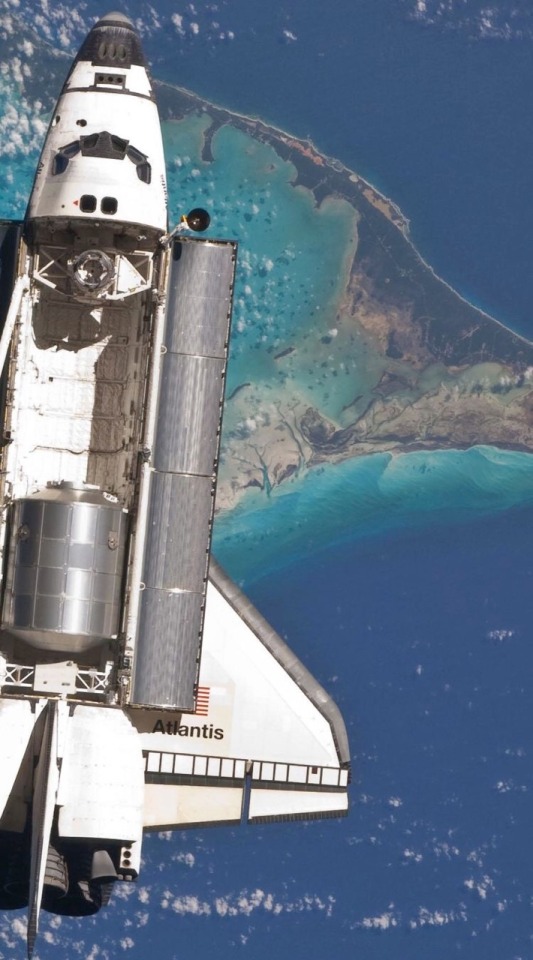
Shuttle Atlantis over the Bahamas. 🚀
Jupiterʼs moons

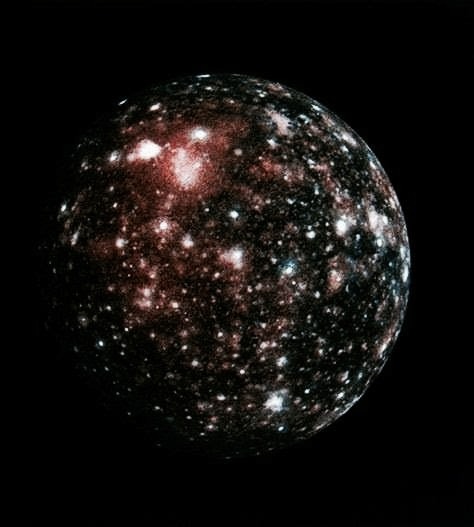


Ganymede, Callisto, Io and Europa


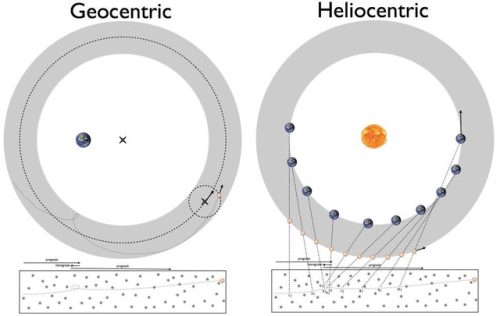






What Separates A Good Scientific Theory From A Bad One?
“It’s why an idea like dark matter is so powerful. By adding just a single new species of particle — something that’s cold, collisionless, and transparent to light and normal matter — you can explain everything from rotating galaxies to the cosmic web, the fluctuations in the microwave background, galaxy correlations, colliding galaxy clusters, and much, much more. It’s why ideas with a huge number of free parameters that must be tuned to get the right results are less satisfying and less predictively powerful. If we can model dark energy, for instance, with just one constant, why would we invent multi-field models with many parameters that are no more successful?”
You’ve often heard, when discussing competing scientific ideas, of appealing to Occam’s razor. Often paraphrased as “all things being equal, the simplest explanation is usually best,” it seems to open the door for people to argue over which explanation is simplest. This should not, however, be a point of contention: the explanation that’s simplest is the one that introduces the fewest number of new, additional free parameters. And when it comes to all things being equal, the things in question ought to be the number of new phenomena the novel idea can explain, along with the number of discernible predictions as compared with the old, prevailing idea. The best scientific ideas are the ones that explain the most by adding the least, while the worst ones unnecessarily add additional parameters on top of what we observe for no good reason other than personal bias. Ideas may be a dime-a-dozen, but a good idea is hard to find.
The next time you encounter an interesting, wild idea that someone throws out there, use this criteria to evaluate it. You just might be surprised at how quickly you can tell whether an idea is good or bad!
One Step Closer to the Moon with the Artemis Program! 🌙

The past couple of weeks have been packed with milestones for our Artemis program — the program that will land the first woman and the next man on the Moon!

Artemis I will be an integrated, uncrewed test of the Orion spacecraft and Space Launch System (SLS) rocket before we send crewed flights to the Moon.

On March 2, 2021, we completed stacking the twin SLS solid rocket boosters for the Artemis I mission. Over several weeks, workers with NASA's Exploration Ground Systems used one of five massive cranes to place 10 booster segments and nose assemblies on the mobile launcher inside the Vehicle Assembly Building at the Kennedy Space Center (KSC) in Florida.
On March 18, 2021, we completed our Green Run hot fire test for the SLS core stage at Stennis Space Center in Mississippi. The core stage includes the flight computers, four RS-25 engines, and enormous propellant tanks that hold more than 700,000 gallons of super cold propellant. The test successfully ignited the core stage and produced 1.6 million pounds of thrust. The next time the core stage lights up will be when Artemis I launches on its mission to the Moon!

In coming days, engineers will examine the data and determine if the stage is ready to be refurbished, prepared for shipment, and delivered to KSC where it will be integrated with the twin solid rocket boosters and the other rocket elements.
We are a couple steps closer to landing boots on the Moon!
Make sure to follow us on Tumblr for your regular dose of space: http://nasa.tumblr.com
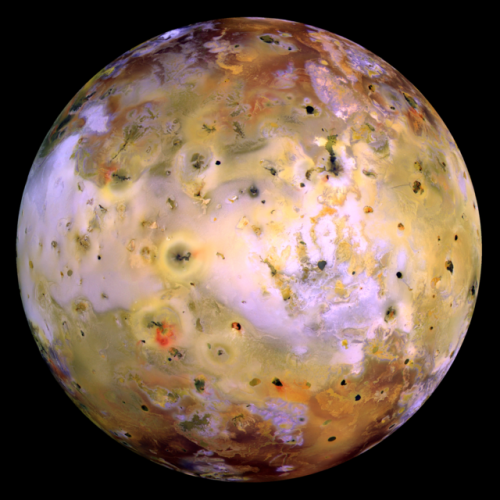
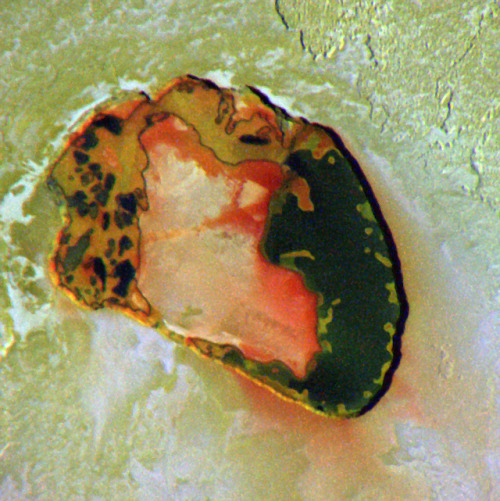
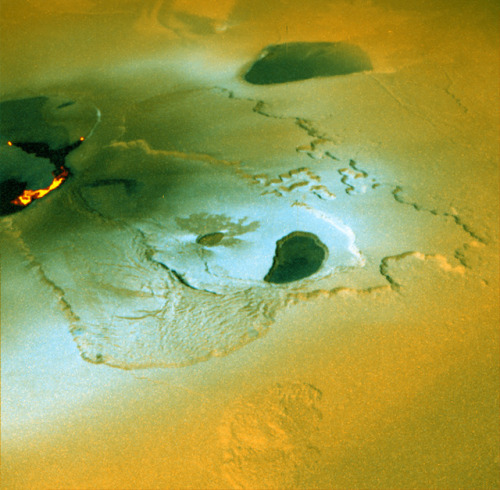
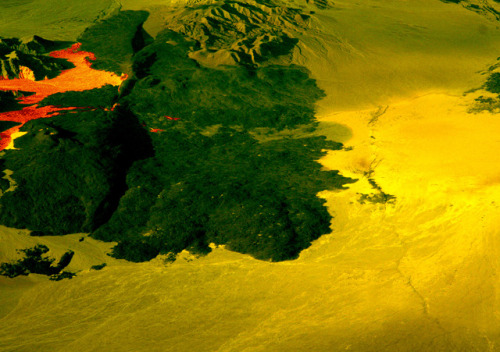
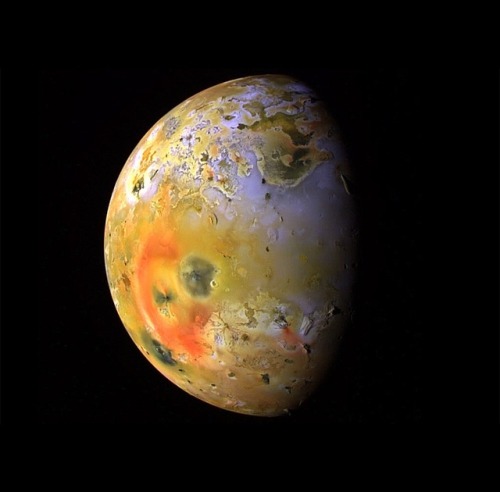
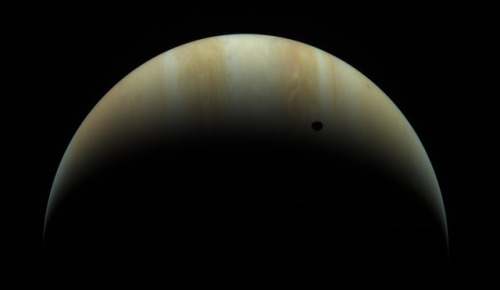
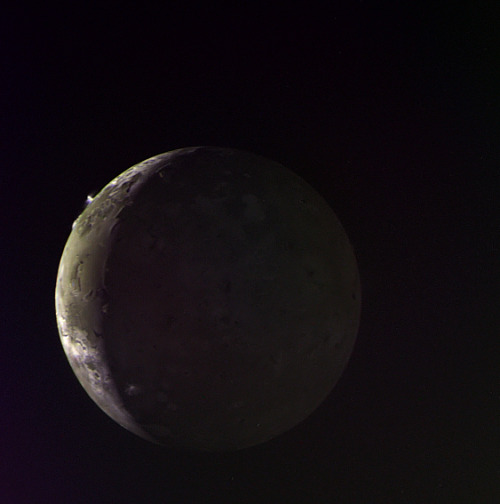
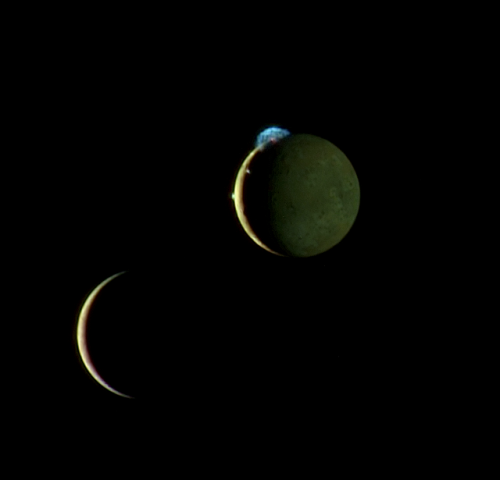
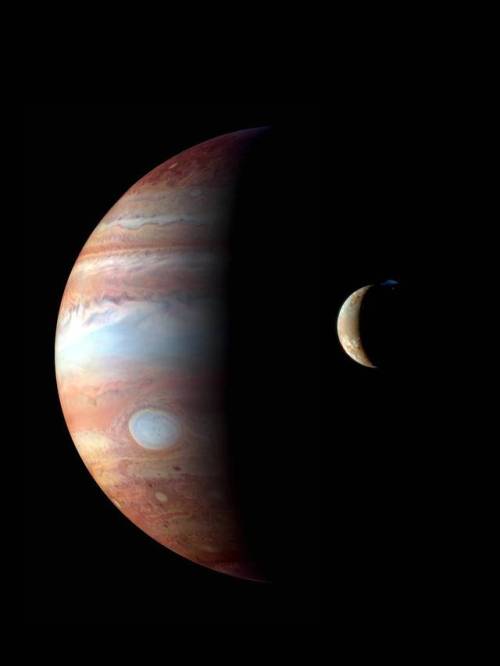
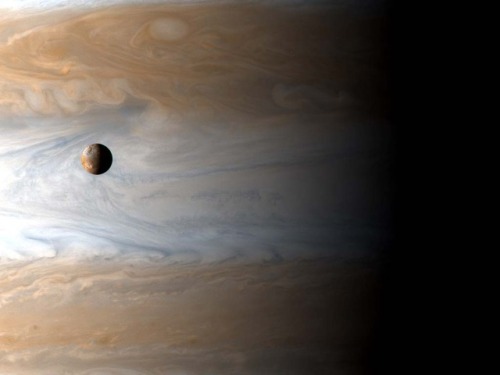
Io - The Volcanic Moon
Looking like a giant pizza covered with melted cheese and splotches of tomato and ripe olives, Io is the most volcanically active body in the solar system. Volcanic plumes rise 300 km (190 miles) above the surface, with material spewing out at nearly half the required escape velocity.
A bit larger than Earth’s Moon, Io is the third largest of Jupiter’s moons, and the fifth one in distance from the planet.
Although Io always points the same side toward Jupiter in its orbit around the giant planet, the large moons Europa and Ganymede perturb Io’s orbit into an irregularly elliptical one. Thus, in its widely varying distances from Jupiter, Io is subjected to tremendous tidal forces. These forces cause Io’s surface to bulge up and down (or in and out) by as much as 100 m (330 feet)! Compare these tides on Io’s solid surface to the tides on Earth’s oceans. On Earth, in the place where tides are highest, the difference between low and high tides is only 18 m (60 feet), and this is for water, not solid ground!
This tidal pumping generates a tremendous amount of heat within Io, keeping much of its subsurface crust in liquid form seeking any available escape route to the surface to relieve the pressure. Thus, the surface of Io is constantly renewing itself, filling in any impact craters with molten lava lakes and spreading smooth new floodplains of liquid rock. The composition of this material is not yet entirely clear, but theories suggest that it is largely molten sulfur and its compounds (which would account for the varigated coloring) or silicate rock (which would better account for the apparent temperatures, which may be too hot to be sulfur). Sulfur dioxide is the primary constituent of a thin atmosphere on Io. It has no water to speak of, unlike the other, colder Galilean moons. Data from the Galileo spacecraft indicates that an iron core may form Io’s center, thus giving Io its own magnetic field.
Io was discovered on 8 January 1610 by Galileo Galilei. The discovery, along with three other Jovian moons, was the first time a moon was discovered orbiting a planet other than Earth.

Eruption of the Tvashtar volcano on Jupiter’s moon Io, photographed by New Horizons.
Image credit: NASA/JPL/Galileo/New Horizons ( Stuart Rankin, Kevin Gill)
Source: NASA
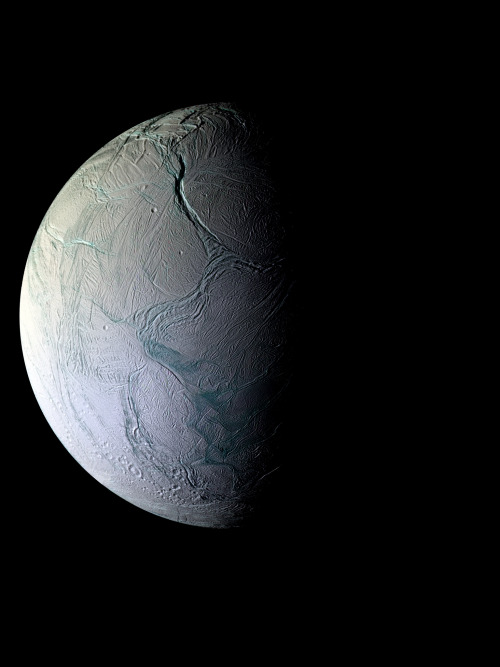
Image of the moon of Saturn, Enceladus, taken by the Cassini spacecraft
Image credit: NASA / JPL




jupiter
-
 saltythexfilesindianjonescop liked this · 8 months ago
saltythexfilesindianjonescop liked this · 8 months ago -
 runforrestr reblogged this · 1 year ago
runforrestr reblogged this · 1 year ago -
 runforrestr liked this · 1 year ago
runforrestr liked this · 1 year ago -
 hyinen liked this · 2 years ago
hyinen liked this · 2 years ago -
 wiishopwednesday reblogged this · 2 years ago
wiishopwednesday reblogged this · 2 years ago -
 wiishopwednesday liked this · 2 years ago
wiishopwednesday liked this · 2 years ago -
 sergioballester-blog reblogged this · 4 years ago
sergioballester-blog reblogged this · 4 years ago -
 sergioballester-blog liked this · 4 years ago
sergioballester-blog liked this · 4 years ago -
 squirmv reblogged this · 4 years ago
squirmv reblogged this · 4 years ago -
 leoncita888 reblogged this · 5 years ago
leoncita888 reblogged this · 5 years ago -
 leoncita888 liked this · 5 years ago
leoncita888 liked this · 5 years ago -
 lovelysquonk-blog liked this · 6 years ago
lovelysquonk-blog liked this · 6 years ago -
 simonedwin liked this · 6 years ago
simonedwin liked this · 6 years ago -
 billnabru-blog liked this · 6 years ago
billnabru-blog liked this · 6 years ago -
 sgw65-blog liked this · 7 years ago
sgw65-blog liked this · 7 years ago -
 agrirs liked this · 7 years ago
agrirs liked this · 7 years ago -
 thomj reblogged this · 7 years ago
thomj reblogged this · 7 years ago -
 chacecogar reblogged this · 10 years ago
chacecogar reblogged this · 10 years ago -
 flanuernyctophiliac liked this · 10 years ago
flanuernyctophiliac liked this · 10 years ago -
 flanuernyctophiliac reblogged this · 10 years ago
flanuernyctophiliac reblogged this · 10 years ago -
 howardtonypotts reblogged this · 11 years ago
howardtonypotts reblogged this · 11 years ago -
 howardtonypotts liked this · 11 years ago
howardtonypotts liked this · 11 years ago -
 chlengor liked this · 11 years ago
chlengor liked this · 11 years ago -
 wachizombis reblogged this · 11 years ago
wachizombis reblogged this · 11 years ago -
 caramellattebaby liked this · 11 years ago
caramellattebaby liked this · 11 years ago -
 riotboy1 liked this · 11 years ago
riotboy1 liked this · 11 years ago -
 humr-me liked this · 11 years ago
humr-me liked this · 11 years ago -
 countingbirds reblogged this · 11 years ago
countingbirds reblogged this · 11 years ago -
 voyager1 reblogged this · 14 years ago
voyager1 reblogged this · 14 years ago